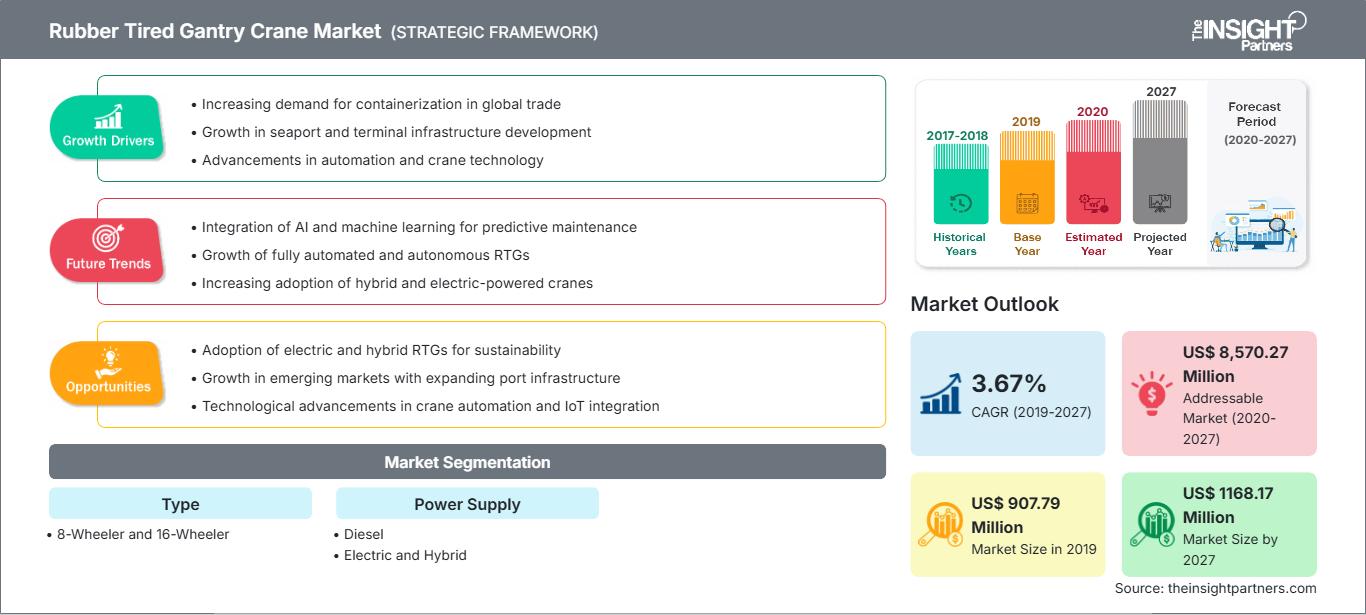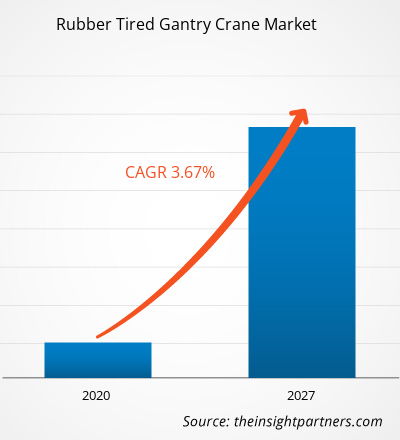El mercado de grúas pórtico con neumáticos se valoró en USD 907,79 millones en 2019 y se proyecta que alcance los USD 1168,17 millones para 2027; se espera que crezca a una CAGR del 3,67% entre 2020 y 2027.
Anteriormente, los países en desarrollo eran proveedores de materias primas; sin embargo, la estructura del comercio les ha otorgado un nuevo papel a nivel mundial, por lo que se prevé que el mercado de grúas pórtico sobre neumáticos experimente un crecimiento significativo durante el período de pronóstico. Este crecimiento del mercado se atribuye principalmente al aumento de la demanda de comercio marítimo, ya que los países en desarrollo, incluida China, se están consolidando como importantes importadores y exportadores de mercancías por vía marítima, siendo Asia la principal región comercial.
Además, el mercado de grúas pórtico sobre neumáticos se ve impulsado por iniciativas gubernamentales favorables para el desarrollo portuario. Un puerto se convierte en un motor de la economía si funciona correctamente. Hoy en día, el propósito de un puerto no solo es limitado, sino que se ha extendido a una plataforma logística. La productividad de un puerto es importante para el comercio internacional, ya que un puerto marítimo es el eje central del comercio exterior de un país. Se están implementando diversas políticas gubernamentales que, a su vez, impulsarán el mercado mundial de grúas pórtico sobre neumáticos durante el período de pronóstico.
Europa lideró el mercado de grúas pórtico sobre neumáticos en 2019 y se espera que mantenga su dominio durante el período de pronóstico. Los puertos europeos han adoptado RTG eléctricas para reducir la contaminación y las emisiones de gases de efecto invernadero. Las regulaciones gubernamentales en esta región han permitido la adopción de equipos eléctricos para la manipulación de contenedores, como la verificación de emisiones de carbono en el transporte marítimo. Europa representa un gran volumen de comercio de productos y activos, como maquinaria, vehículos, aeronaves, combustibles, metales no ferrosos, textiles, productos químicos, ropa y petróleo crudo. Europa ocupa el primer lugar en comercio, lo que la convierte en la región líder en el mercado mundial de grúas pórtico sobre neumáticos.
Personalice este informe según sus necesidades
Obtendrá personalización en cualquier informe, sin cargo, incluidas partes de este informe o análisis a nivel de país, paquete de datos de Excel, así como también grandes ofertas y descuentos para empresas emergentes y universidades.
Mercado de grúas pórtico sobre neumáticos: Perspectivas estratégicas

-
Obtenga las principales tendencias clave del mercado de este informe.Esta muestra GRATUITA incluirá análisis de datos, desde tendencias del mercado hasta estimaciones y pronósticos.
Impacto de la pandemia de COVID-19 en el mercado de grúas pórtico sobre neumáticos
La crisis del COVID-19 está afectando a las industrias de todo el mundo y se prevé que la economía global se vea especialmente afectada tanto en 2020 como en 2021. El brote ha generado importantes disrupciones en industrias primarias como la electrónica de consumo, los semiconductores, la automoción y la infraestructura de TI. Todas estas industrias son cruciales para el crecimiento del mercado global de grúas pórtico con neumáticos, ya que son las principales generadoras de demanda de este tipo de grúas. El cierre de fábricas, las prohibiciones de viaje, las prohibiciones comerciales y los cierres fronterizos han afectado tanto a la fabricación como a las ventas de diversos productos y componentes electrónicos de consumo. La industria global de la electrónica y los semiconductores es una de las principales industrias que se enfrenta a graves disrupciones debido a problemas en la cadena de suministro y cierres de la fabricación.
Perspectivas del mercado
Enfoque creciente hacia la tecnología verde
Los participantes del mercado se centran en la tecnología ecológica debido a las estrictas regulaciones gubernamentales sobre contaminación y límites de emisiones en diversas regiones. Además, el uso de RTG equipadas con accionamientos eléctricos puede optimizarse para un menor consumo de energía. El uso de tecnología híbrida de batería en las grúas se centrará en reducir sustancialmente el consumo de combustible y las emisiones nocivas de combustibles fósiles. Aproximadamente el 10% de las emisiones de combustible diésel de los equipos de manipulación de carga en los puertos provienen de grúas RTG; la implementación de RTG más eficientes reduce directamente el impacto ambiental de las operaciones de grúas. Esta tecnología es una respuesta para los operadores portuarios de todo el mundo que necesitan aumentar la eficiencia a la vez que reducen las emisiones y el impacto ambiental de sus operaciones, además de ofrecer beneficios adicionales como la reducción de los costos operativos con menores emisiones de gases de efecto invernadero y niveles de ruido más bajos en la terminal. La tecnología de almacenamiento de energía mediante volante de inercia para grúas pórtico con neumáticos o RTG puede modernizarse en grúas RTG existentes o incluirse como parte de una nueva construcción. Los volantes de inercia ofrecen reducción de combustible y emisiones al capturar la energía de frenado producida al bajar un contenedor.
Perspectivas del mercado basadas en tipos
Según el tipo, el mercado global de grúas pórtico sobre neumáticos se divide en dos segmentos: grúas de 8 y 16 ruedas. Existen dos tipos para cada modelo: 8W y 8WA para las grúas de 8 ruedas, y 16W y 16WA para las grúas de 16 ruedas. Las principales diferencias entre ambos modelos residen en el diseño del sistema antibalanceo y el número de ruedas del pórtico. Las grúas RTG de 16 neumáticos requieren una mayor superficie de desplazamiento, por lo que no pueden utilizarse en espacios reducidos. Las grúas RTG de 8 neumáticos son las preferidas para espacios reducidos.
Perspectivas del mercado basadas en el suministro de energía
Según el suministro de energía, el mercado global de grúas pórtico con neumáticos se puede clasificar en tres categorías: diésel, eléctricas e híbridas. La implementación de estrictas normas de emisiones para minimizar las emisiones globales, el desarrollo de vehículos eléctricos más eficientes y el aumento de los precios del combustible probablemente impulsarán la demanda de grúas RTG eléctricas e híbridas en todo el mundo. Las grúas RTG eléctricas ofrecen un mejor rendimiento y pueden mover cargas considerables. Por ello, se espera que aumente próximamente la preferencia por las grúas pórtico con neumáticos eléctricos e híbridos.
El desarrollo de productos es una de las estrategias más comunes que adoptan las empresas para ampliar su cartera de productos. Anupam Industries Limited, Electromech Material Handling Systems (India) Pvt. Ltd., Konecranes, Liebherr y Kalmar se encuentran entre las empresas clave que implementan estrategias para ampliar su cartera de clientes y obtener una participación significativa en el mercado de grúas pórtico con neumáticos, lo que les permite mantener su marca en el mercado global.
Perspectivas regionales del mercado de grúas pórtico sobre neumáticos
Los analistas de The Insight Partners han explicado detalladamente las tendencias regionales y los factores que influyen en el mercado de grúas pórtico sobre neumáticos durante el período de pronóstico. Esta sección también analiza los segmentos y la geografía del mercado de grúas pórtico sobre neumáticos en América del Norte, Europa, Asia Pacífico, Oriente Medio y África, y América del Sur y Central.
Alcance del informe de mercado de grúas pórtico con neumáticos
| Atributo del informe | Detalles |
|---|---|
| Tamaño del mercado en 2019 | US$ 907,79 millones |
| Tamaño del mercado en 2027 | US$ 1168,17 millones |
| CAGR global (2019-2027) | 3,67% |
| Datos históricos | 2017-2018 |
| Período de pronóstico | 2020-2027 |
| Segmentos cubiertos |
Por tipo
|
| Regiones y países cubiertos |
América del norte
|
| Líderes del mercado y perfiles de empresas clave |
|
Densidad de actores del mercado de grúas pórtico sobre neumáticos: comprensión de su impacto en la dinámica empresarial
El mercado de grúas pórtico sobre neumáticos está creciendo rápidamente, impulsado por la creciente demanda del usuario final debido a factores como la evolución de las preferencias de los consumidores, los avances tecnológicos y un mayor conocimiento de los beneficios del producto. A medida que aumenta la demanda, las empresas amplían su oferta, innovan para satisfacer las necesidades de los consumidores y aprovechan las tendencias emergentes, lo que impulsa aún más el crecimiento del mercado.

- Obtenga una descripción general de los principales actores clave del mercado de grúas pórtico con neumáticos
Segmentación del mercado de grúas pórtico sobre neumáticos:
Por tipo
- 8 ruedas
- Camión de 16 ruedas
Por fuente de alimentación
- Diesel
- Eléctrico
- Híbrido
Perfiles de empresas
- Industrias Anupam Limitada
- SISTEMAS DE MANEJO DE MATERIALES ELECTROMECH (INDIA) PVT. LTD
- Kalmar
- Konecranes
- Liebherr
- Productos Mi-Jack.
- INDUSTRIAS REVA LTD.
- Industrias Pesadas Shanghai Zhenhua CO., Ltd. (ZPMC)
- Grúas y aparejos TNT
- Grupo Sany
- Análisis histórico (2 años), año base, pronóstico (7 años) con CAGR
- Análisis PEST y FODA
- Tamaño del mercado, valor/volumen: global, regional y nacional
- Industria y panorama competitivo
- Conjunto de datos de Excel
Informes recientes
Testimonios
Razón para comprar
- Toma de decisiones informada
- Comprensión de la dinámica del mercado
- Análisis competitivo
- Información sobre clientes
- Pronósticos del mercado
- Mitigación de riesgos
- Planificación estratégica
- Justificación de la inversión
- Identificación de mercados emergentes
- Mejora de las estrategias de marketing
- Impulso de la eficiencia operativa
- Alineación con las tendencias regulatorias






















 Obtenga una muestra gratuita para - Mercado de grúas pórtico sobre neumáticos
Obtenga una muestra gratuita para - Mercado de grúas pórtico sobre neumáticos